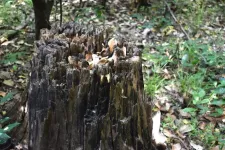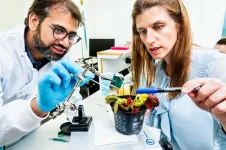(Press-News.org) Rochester Institute of Technology’s Joel Kastner, a professor in the Chester F. Carlson Center for Imaging Science and School of Physics and Astronomy, and a team of researchers with the European Southern Observatory (ESO) have discovered new evidence of how planets as massive as Jupiter can form, using images from the ESO’s Very Large Telescope (VLT) and the Atacama Large Millimeter/submillimeter Array (ALMA).
The combination of VLT and ALMA imaging have yielded detections of dusty clumps close to the young star V960 Mon that could collapse to create giant planets. The work is based on an infrared image obtained with the Spectro-Polarimetric High-contrast Exoplanet Research (SPHERE) instrument on ESO’s VLT and a radio-wavelength image with ALMA that together reveal, in fascinating detail, the material around the star.
This young star attracted astronomers’ attention when it suddenly increased its brightness more than 20 times in 2014. SPHERE observations taken shortly after the onset of this brightness “outburst” revealed that the material orbiting V960 Mon is assembling together in a series of intricate spiral arms extending over distances bigger than the entire solar system.
Kastner worked on the SPHERE imaging project with former RIT student David Principe ’14 Ph.D. (astrophysical sciences and technology), who is now at the Kavli Institute for Astrophysics and Space Research at the Massachusetts Institute of Technology.
“The two of us put SPHERE observing proposals together to look at these outbursting objects,” said Kastner. “We were hoping to see structure around them that is lit up by the outbursts, but we really weren’t sure what kind of structure we might see. We thought we might be able to see the dusty material around the star that is feeding the star and maybe forming planets, and this was a great case where both appear to have been detected.”
Astronomers believe that giant planets form either by “core accretion,”’ when dust grains slowly coagulate to form a massive core that sweeps up gas, or by “gravitational instability,” when large fragments of the material around a star quickly contract and collapse. While researchers have previously found evidence for the first of these scenarios, support for the latter has been scant. The images from VLT now show a real observation of gravitational instability happening at planetary scales.
“It’s a confirmation that one of the basic ideas of how planets form works,” said Kastner. “It’s a pretty good demonstration of what has been shown in very detailed simulations of discs around young stars to determine if they are making planets.”
The research team presented its findings in the July 25 issue of The Astrophysical Journal Letters. Authors span across the globe while the VLT and ALMA are located in Chile’s Atacama Desert.
The ESO enables scientists worldwide to discover the secrets of the universe for the benefit of all. Established as an intergovernmental organization in 1962, today ESO is supported by 16 member states (Austria, Belgium, the Czech Republic, Denmark, France, Finland, Germany, Ireland, Italy, the Netherlands, Poland, Portugal, Spain, Sweden, Switzerland, and the United Kingdom), along with the host state of Chile and with Australia as a strategic partner.
ALMA is an international astronomy facility in partnership with the ESO, the U.S. National Science Foundation (NSF), and the National Institutes of Natural Sciences (NINS) of Japan in cooperation with the Republic of Chile. ALMA is funded by ESO on behalf of its member states, by NSF in cooperation with the National Research Council of Canada (NRC), the National Science and Technology Council (NSTC) in Taiwan, and by NINS in cooperation with the Academia Sinica (AS) in Taiwan and the Korea Astronomy and Space Science Institute (KASI).
END
RIT professor co-authors paper on new planetary formation findings
Joel Kastner contributes to discovery made by an international team through the European Southern Observatory
2023-07-26
ELSE PRESS RELEASES FROM THIS DATE:
Delaying methane mitigation increases risk of breaching Paris Agreement climate goal, study finds
2023-07-26
A new study by Simon Fraser University researchers shows that efforts to reduce methane emissions are needed immediately if we are to meet global climate change goals.
A key element of the 2015 Paris Agreement, a legally binding international treaty on climate change, is the commitment to limit average global temperatures increases to well below 2°C above pre-industrial levels, and pursue efforts to limit global warming to 1.5°C above pre-industrial levels. This requires reaching net-zero CO2 emissions by or around 2050—and deep reductions in methane and other ...
Lizards may miss out on mating opportunities and pick partners more hastily under warming temperatures
2023-07-26
Lizards may miss out on mating opportunities and pick partners more hastily under warming temperatures
###
Article URL: https://journals.plos.org/plosone/article?id=10.1371/journal.pone.0285656
Article Title: Behavioural plasticity in activity and sexual interactions in a social lizard at high environmental temperatures
Author Countries: Argentina
Funding: N.R. - Student Research Grant 2019 - Animal Behavior Society https://www.animalbehaviorsociety.org/web/index.php. M. C. - Consejo Nacional ...
Fungi which normally decay wood can effectively break down low density polyethylene (LDPE) plastic instead - and do so best in the absence of wood
2023-07-26
Fungi which normally decay wood can effectively break down low density polyethylene (LDPE) plastic instead - and do so best in the absence of wood
###
Article URL: https://journals.plos.org/plosone/article?id=10.1371/journal.pone.0288133
Article Title: Wood decay fungi show enhanced biodeterioration of low-density polyethylene in the absence of wood in culture media
Author Countries: Sri Lanka
Funding: 1. RNA: TWAS research grant 18-020 RG/BIO/AS_I The world academy of science https://twas.org/ 2. RNA, PW, HH: ICGEB research grant CRP/LKA18-03 https://www.icgeb.org/ International Center for genetic engineering and biotechnology 3. RNA, HH: t(NSF/RG/2019/BT/03). http://www.nsf.ac.lk/ ...
Fast electrical signals mapped in plants with new bioelectronic technology
2023-07-26
What happens inside the carnivorous plant Venus Flytrap when it catches an insect? New technology has led to discoveries about the electrical signalling that causes the trap to snap shut. Bioelectronic technology enables advanced research into how plants react to their surroundings, and to stress.
Most people know that the nervous system in humans and other animals sends electric impulses. But do plants also have electrical signals even though they lack a nervous system? Yes, plants have electrical signals that are generated in response to touch and stress factors, such as wounds caused by herbivores and attacks on their roots. As opposed to animals, who can move out of the ...
Aphids make tropical milkweed less inviting to monarch butterflies, study finds
2023-07-26
Many gardeners will tell you that aphids are the bane of their existence. According to a new study from the University of Florida, these tiny pests also pose problems for the iconic monarch butterfly. The study found that when oleander aphids infested tropical milkweed — a nonnative milkweed species commonly used across southern portions of the U.S. stretching from California to Florida — the butterflies laid fewer eggs on the plants, and caterpillars developing on those plants were slower to mature.
Monarch butterflies depend on milkweed and its close relatives to complete their life ...
Climate change threatens 771 endangered plant and lichen species
2023-07-26
All plants and lichens listed as endangered under the Endangered Species Act are sensitive to climate change but there are few plans in place to address this threat directly, according to a new study by Amy Casandra Wrobleski of Pennsylvania State University and colleagues, published July 26, 2023 in the open-access journal PLOS Climate.
Climate change is expected to have a major impact on species around the world, especially endangered species, which are already rare. A majority of the organisms listed under the Endangered Species Act are ...
Increased step count linked to better health for people with heart failure
2023-07-26
More often, people are turning to consumer wearable devices, such as smartwatches, to monitor their health and physical activity.
Using these wearable devices, a study led by Michigan Medicine and the University of Missouri with Saint Luke’s Mid America Heart Institute finds that taking more daily steps is associated improved health, including fewer symptoms and physical limitations, for people with heart failure. The results are published in JACC: Heart Failure.
Clinicians are increasingly presented with their patients’ wearable device data, ...
NIH spent $950M for basic or applied research leading to patents providing market exclusivity for drugs approved 2010-19
2023-07-26
BENTLEY UNIVERSITY
A new study from Bentley University’s Center for Integration of Science and Industry demonstrates that the National Institutes of Health (NIH) spent $950 million on basic or applied research associated with patents that provided manufacturers with market exclusivity. This amount represents <1% (0.59%) of the $164 billion in total NIH funding for research contributing to the approval of these products.
The article in PLOS ONE titled “NIH funding for patents that contribute ...
People with heart failure can step their way to better health
2023-07-26
People with heart failure who increase their daily step count also saw improvements in their health status over a 12-week period, according to a study published today in JACC: Heart Failure. The study suggests that physical data from wearable devices, such as step count, can be clinically significant and has the potential to inform future clinical trials and clinical care.
Consumer wearable devices to track health status and progress are commonly used and part of a growing trend of mobile health technology. However, how to interpret data from wearable devices, including step count, is at times ...
Ancient DNA reveals diverse community in “Lost City of the Incas”
2023-07-26
Who lived at Machu Picchu at its height? A new study, published today in Science Advances, used ancient DNA to find out for the first time where workers buried more than 500 years ago came from within the lost Inca Empire.
Researchers, including Jason Nesbitt, associate professor of archaeology at Tulane University School of Liberal Arts, performed genetic testing on individuals buried at Machu Picchu in order to learn more about the people who lived and worked there.
Machu Picchu is a UNESCO World Heritage Site located in the Cusco ...
LAST 30 PRESS RELEASES:
Report on academic exchange (colloquium) with Mapua University
Sport in middle childhood can breed respect for authority in adolescence
From novel therapies to first-in-human trials, City of Hope advances blood cancer care at the American Society of Hematology (ASH) annual conference
Research aims to strengthen the security of in-person voting machines
New study exposes hidden Alzheimer’s 'hot spots' in rural Maryland and what they reveal about America’s growing healthcare divide
ASH 2025: Study connects Agent Orange exposure to earlier and more severe cases of myelodysplastic syndrome
ASH 2025: New data highlights promise of pivekimab sunirine in two aggressive blood cancers
IADR elects George Belibasakis as vice-president
Expanding the search for quantum-ready 2D materials
White paper on leadership opportunities for AI to increase employee value released by University of Phoenix College of Doctoral Studies
ASH 2025: New combination approach aims to make CAR T more durable in lymphoma
‘Ready-made’ T-cell gene therapy tackles ‘incurable’ T-cell leukemia
How brain activity changes throughout the day
Australian scientists reveal new genetic risk for severe macular degeneration
GLP-1 receptor agonists likely have little or no effect on obesity-related cancer risk
Precision immunotherapy to improve sepsis outcomes
Insilico Medicine unveils winter edition of Pharma.AI, accelerating the path to pharmaceutical superintelligence
Study finds most people trust doctors more than AI but see its potential for cancer diagnosis
School reopening during COVID-19 pandemic associated with improvement in children’s mental health
Research alert: Old molecules show promise for fighting resistant strains of COVID-19 virus
Journal of Nuclear Medicine Technology supplement highlights advances in theranostics and opportunities for growth
New paper rocks earthquake science with a clever computational trick
ASH 2025: Milder chemo works for rare, aggressive lymphoma
Olfaction written in bones: New insights into the evolution of the sense of smell in mammals
Engineering simulations rewrite the timeline of the evolution of hearing in mammals
New research links health impacts related to 'forever chemicals' to billions in economic losses
Unified EEG imaging improves mapping for epilepsy surgery
$80 million in donations propels UCI MIND toward world-class center focused on dementia
Illinois research uncovers harvest and nutrient strategies to boost bioenergy profits
How did Bronze Age plague spread? A sheep might solve the mystery
[Press-News.org] RIT professor co-authors paper on new planetary formation findingsJoel Kastner contributes to discovery made by an international team through the European Southern Observatory



